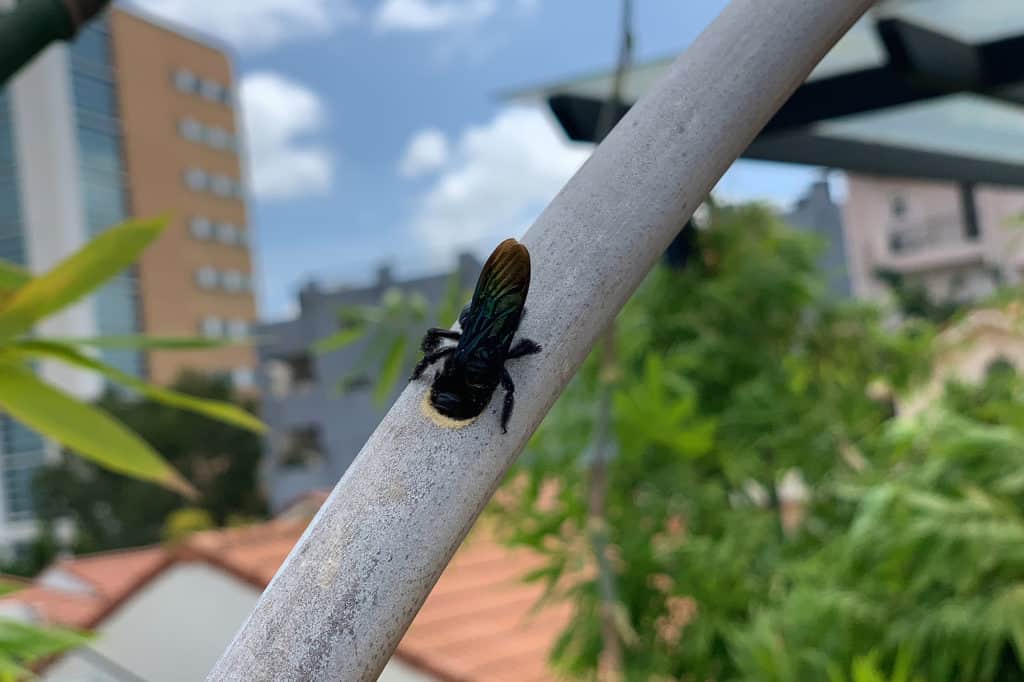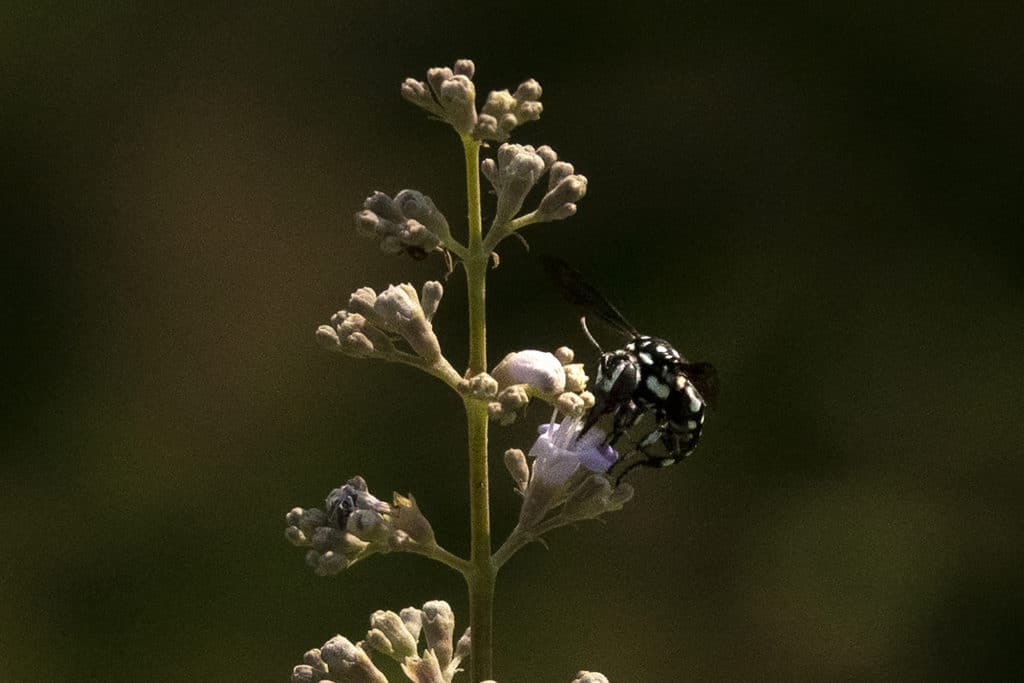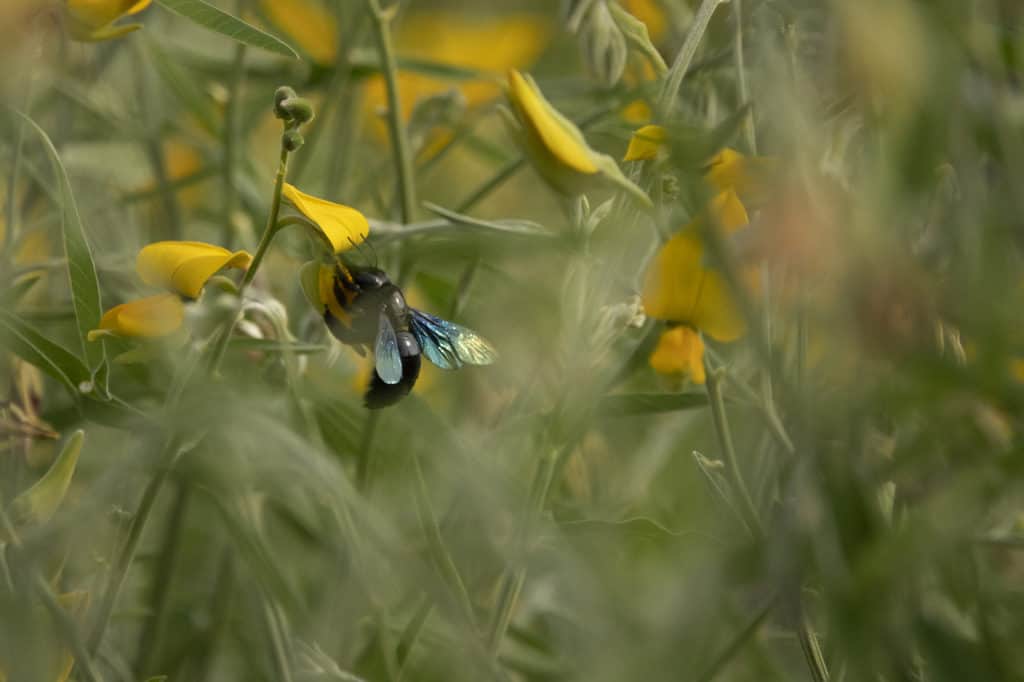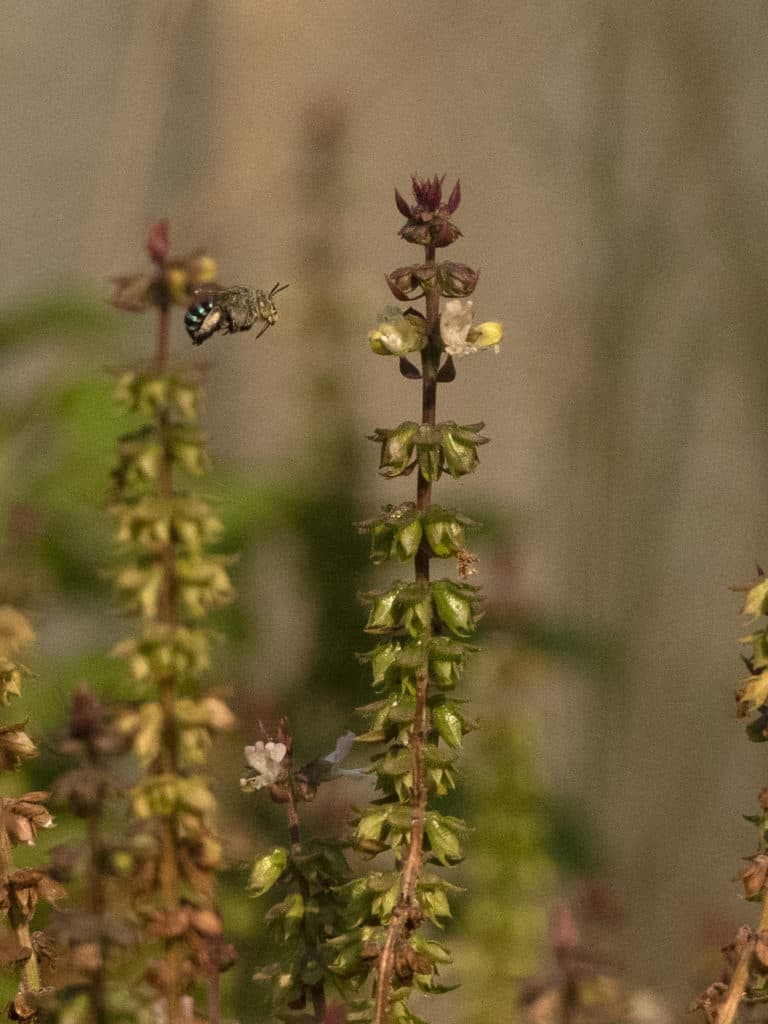One morning in April 2020, early in the lockdown during the COVID-19 pandemic, I leaned over my terrace parapet of my home in Bengaluru, scanning the spreading branches of a Yekke (aak; aakdo; Calotropis gigantea) plant to spot a pale-billed flowerpecker whose trills I could distinctly hear. Eye to the viewfinder, I looked for the bird, the smallest in India at just over 3 inches.
I found something else entirely. A dark form, an obsidian body with sky-blue eyes, was perched on a flower, its head bent into the petals. Hastily focusing on it, I shot off a few frames as it shifted on the flower, on its hairy legs, piercing the base of each petal in turn and sucked nectar.
Drawing back from the edge of the parapet, I squinted at the LCD display of my camera. The shifting iridescence — blue, purple, green, ochre — in its wings was stunning. Later that day, I posted the photo to Twitter, mistakenly calling the wondrous creature a bumblebee.
“It’s a carpenter bee,” a wildlife biologist corrected me. “The only bumblebees in India are found in the Himalayas.” Thus started my journey into a fascinating, lesser-known world — the world of the carpenter bee, genus Xylocopa.

One of the best kept secrets of the bee-world is this: of the 20,400 species of bees in the world, over 90% do not live in hives and do not make any honey. That percentage shoots up in India, where of the 700 or so bee species, only five are social bees, living in hives and making honey.
The rest are “solitary” bees — there is no “queen bee” or “workers,” no social hierarchy. These bees live solo and forage and fend for themselves. Moreover, they play an important role in our world. Solitary bees are crucial to the pollination success of several crops like cucurbits, blueberry, cranberry, tomatoes, eggplants, apples, plums, almonds, and all manner of lentils, among others.
- There are over 20,000 species of bees in the world. Most of them are solitary bees that do not live in hives and do not make any honey.
- Solitary bees live solo and forage and fend for themselves. The availability of nesting sites are key to the survival of these species.
- As bees are important pollinators, increasing nesting sites for solitary bees around farms where such crops are grown is known to be beneficial.
Bees have always found a special place in the human imagination. Bhramari in Hindu mythology is a bee-goddess, an incarnation of Goddess Parvati, the consort of Lord Shiva. Legend has it that Parvati commands all the bees, wasps, and flies of the world which cling to her body, and she assumes the avatar of Bhramari in battle against the demon Arunasura.
The demon, invincible by way of boons received in penance, is nevertheless vanquished when hordes of bees and wasps leave Bhramari’s body at her command and attack him. The big, black, shiny carpenter bee, “bhramara,” appears often in Sanskrit poetry, usually hovering around young maidens, as a symbol of lovesick men.

Bees in the backyard
Except for one introduced social honeybee species — Apis mellifera — all the bees found in India (solitary and social) are native bees. And of the native solitary bees, the one I’d just seen foraging was the largest: the female Xylocopa latipes.
Read more: City of blinding lights: Artificial light disturbs nature’s processes in Bengaluru
Thoroughly intrigued, I began to look out for bees in my overgrown, wild urban garden in which I had tried to plant mostly native, flowering plants. At least four species of carpenter bees came each day, and several other species of solitary bees occasionally.
Signs were everywhere. Leaves neatly sculpted and carved out meant leaf-cutter bees had been at work. Eyes staring from thin hollow sticks and wall crevices meant mason bees roosting. Bees with abdomens banded blue and green, some black and yellow, others polka-dotted blue and black were everywhere, once I started looking.

Only two of the many species of bees in my garden turned out to be honeybees. They bookended the size spectrum of honeybees found in India: the largest, the giant Indian honey bee or rock bee, Apis dorsata, and the smallest, the dwarf bee, Apis florea.
Peering into the foliage turned up a dwarf-bee hive in an overgrown creeper, from which these tiny bees foray out to forage for nectar and pollen on petrea flowers, moringa flowers, and in a nearby patch of basil.
All the other bees in the garden were solitary bees.

Each morning, as the summer sun came up, the carpenter bees would appear. They followed a pattern — one species (usually the fluffy yellow Xylocopa pubescens) would be the first to arrive, the male leading the way. The taxicab-like female, sporting a yellow thorax and black abdomen, would follow. As the morning droned on, other species would zoom in from various directions.
The last to come, announcing her arrival from afar with a loud buzz of wings beating at over 100 times a second, carrying a veritable little weather system of swirling air along with her, would be the massive Xylocopa latipes — among the largest bees in the world.
Oftentimes, she’d have her legs or the underside of her abdomen covered in yellow pollen. This is what she was collecting, along with nectar, and unwittingly depositing, thus assisting in pollination. She was provisioning for her next generation.
Female carpenter bees carry the nectar in their bellies, and pollen on their legs and on the undersides of their abdomen, back to their chosen cavity. This female would forage, flying from flower to flower, then belly-full, she’d zoom away eastwards, over and beyond the community wall. There was no way I could follow her and find out where she nested.
Once at her cavity, which, like that of most carpenter bees, could be a bamboo pole or any wooden crevice or burrow, she’d regurgitate the nectar and mix it with pollen to fashion “bee-bread,” a food high in protein and calories. This she will deposit in a chamber, lay a single egg, and seal it. Then she’d move on to the next chamber — chambers are built upon chambers, apartment style, and repeat.
These bees do something very interesting with the topmost chamber in their nest. The egg they lay in that chamber hatches male. This male pushes out of the topmost chamber and prepares to mate with other females. How mother bees engineer this is still not very well understood.
The bee-bread serves as food for the new larva that will emerge, eat, pupate, and itself emerge as a bee, make its way out of the chamber to mate, provision, and carry on the lineage. Mother would likely never meet the offspring. These species are truly “solitary.”
Necessary nesting sites
V.V. Belavadi of the Entomology department at Gandhi Krishi Vignyan Kendra (GKVK) has studied solitary bees for four decades. “The availability of nesting sites are key to the survival of these species,” he says. Solitary bees tend to live separately, with only the female building a nest. Sometimes females will build burrows or bore holes close to one another, but rarely do solitary bees share nests.

The males find grasses or other surfaces to hold on to, or little depressions to sleep in at night — they do not build or use nests. Carpenter bees, as their name suggests, carve holes into wood or bamboo with their powerful mandibles. Others, like mason bees, blue-banded bees, and leaf-cutter bees burrow into mud or nest in small cavities.
During the process of urbanisation, mud and bamboo and wood and other permeable surfaces are the first to be paved over or clear-cut, replaced by tarmac, tiles, and concrete. This could mean fewer nesting sites for solitary bees. “Loss of nesting sites is one of the strongest predictors of species biodiversity decline,” says Belavadi.
Somanathan of IISer Trivandrum concurs. “Even more than food sources — for these solitary bees are generalists and could manage fine in urban gardens — it is nesting sites that determine the health of their population.”
Precious pollinators
“We have shown that in pigeon pea (toor dal, in Hindi) plots, if you increase nesting sites, you can almost double the pod-set,” says Belavadi, based on some preliminary findings. While pigeon pea can self-pollinate, that is, produce pod sets without the aid of an external pollinator, the yield is only 18-20% in such cases.
If left open to pollinate, without any help to the pollinators, the yield rises to 30-35%. But if solitary bees — in the case of the pigeon pea it is leaf-cutter bees — are provided additional nesting sites (like hollow reeds, pipes, bamboos) close to pigeon pea plots, the yield jumps to 50-60%, explains Belavadi, while noting that more research is needed to confirm the findings.
Some important crop plants like chilies, bell peppers, and tomatoes need to be “buzz-pollinated.” The anthers in such flowers require a certain amount of vibration in order for them to release pollen. The exact mechanism of release is still being studied, but that bees play an important role in providing this vibration through their wingbeat frequency is key.
“Solitary bees are very efficient at buzz-pollination,” says Somanathan, “Not so much honeybees.” Thus, increasing nesting sites for solitary bees around farms where such crops are grown is known to be beneficial. This holds true for urban and peri-urban farms, kitchen gardens, and terrace gardens as well.

Moreover, studies have shown spillover effects where rural agricultural land that borders urban spaces are helped by a high incidence of pollinators in the urban areas.
While there is little data from India or for Indian cities, studies in other parts of the world have compared the health of pollinator (specifically bee) populations and species biodiversity in natural and semi-natural areas with urban sprawl, manicured urban gardens, dense concrete cities, rural sites of intensive agriculture, and urban and rural commons.
The results are instructive and illuminating for city planners and residents alike, pointing to distinct strategies for increasing pollinator diversity and protecting bee populations.
Read more: Body to protect Bengaluru’s biodiversity revived, but can it help?
Studies show that native bee diversity is most adversely affected in areas of intense monoculture agriculture with a heavy use of pesticides and chemicals. These landscapes tend to be resource-poor.
Most urban areas have been shown to be dominated by generalist species of solitary bees, happy to forage on exotic plants. This crowds out species that have a narrower foraging strategy which would likely have been satisfied in natural or semi-natural spaces with a high biodiversity of native flora. This also works the other way around, when pollinators that prefer certain host plants or native species are crowded out, exotic or invasive species take over the urban scapes.
Impacts of urbanisation
With urbanisation has come the heat-island effect. Research shows that when trees that line our roads are chopped down, the ambient air temperature increases by 3.5 degrees Celsius. The surface temperature of the tarmac shoots up by 25-30 degrees Celsius.
By the end of the century, our cities could be 7 degrees hotter and that oven has been turned on. Such temperature changes favour species that prefer warmth while foraging. They take to the warmer micro-habitats like city centers which may be food-resource rich by way of ornamental flowers, while bee species that prefer the cooler temperatures will likely be edged out to the outskirts, which may not be as rich in food sources.
The effect of light, noise, pollution, and climate change on solitary bee biodiversity needs far more research, but broadly, generalists tend to do better when the going gets tough, while specialists or species that rely on a narrow range of food resources, or certain native species of flora, tend to suffer.
Read more: Sacred sites in Bengaluru: Where heritage helps conserve biodiversity
But there is hope for our cities, and for solitary bees. Urbanisation per se does not mean lowered solitary bee biodiversity. In fact, urban sprawl, with a green corridor that leads in from the rural or natural landscape till the city center, could foster a high degree of biodiversity if urban planners and landscapers built cities with adequate food resources and ground- and cavity-nesting sites for pollinators in mind.
Even ordinary city residents can make a difference. Somanathan urges urbanites to build “bee-hotels” and host solitary bees. “All it takes is some hollow wooden sticks, or bamboo tied together and hung for the cavity-nesting species, and some soil left free in gardens (not paved or tiled-over) for the ground-nesting species,” she says.

“If we don’t spray harmful chemicals, if we plant cucurbits like pumpkins and tomato plants, or flowering plants like roses and Calotropis — or any plant from the family Fabacae — solitary bees will come.” They will get their nectar and pollen, we’ll get fruits and flowers.
[This article is part of a series on ‘Bengaluru’s Ecosystems and Biodiversity’. This is a joint project with Mongabay India, and is supported by the Bengaluru Sustainability Forum]
Also Read:
- Bengaluru’s yes to Hesaraghatta film-city means a no to the Lesser Florican
- Unchecked tree loss is wiping out the Slender Loris from Bengaluru
- Not just Lalbagh, your small neighbourhood park too can protect Bengaluru’s biodiversity
- A flower that deceives and entraps!